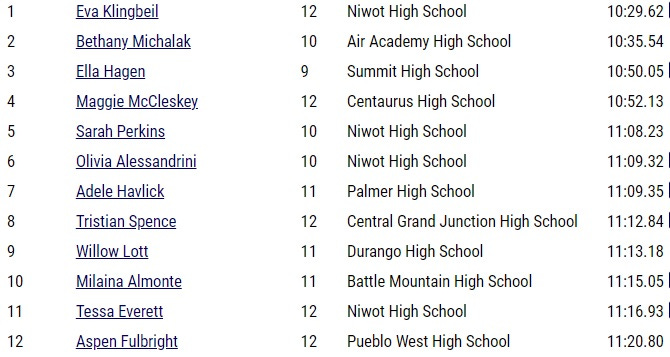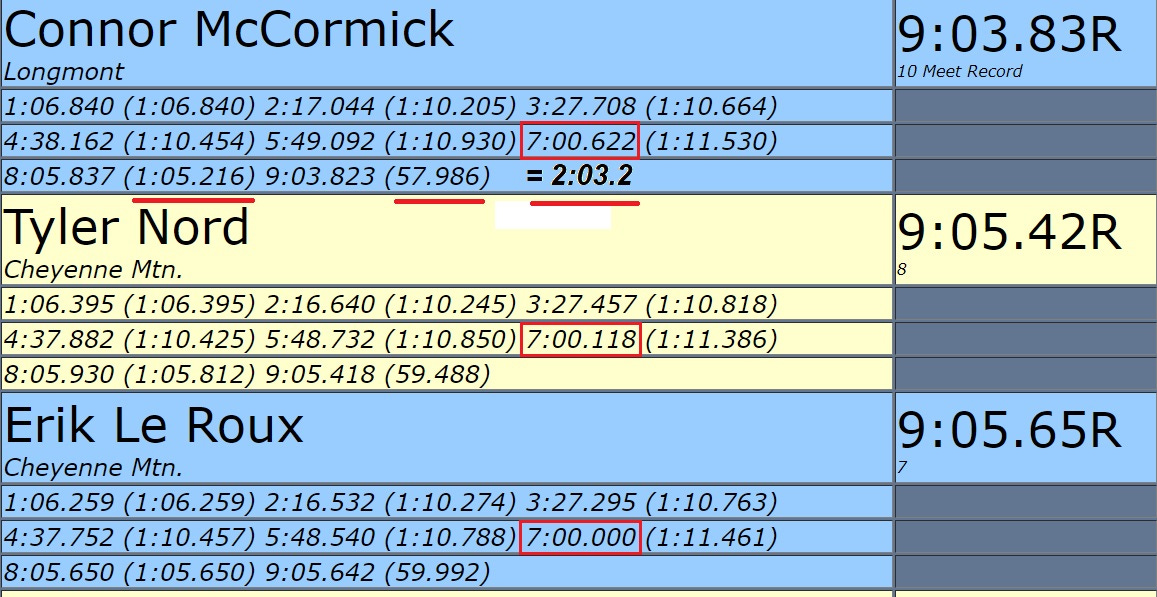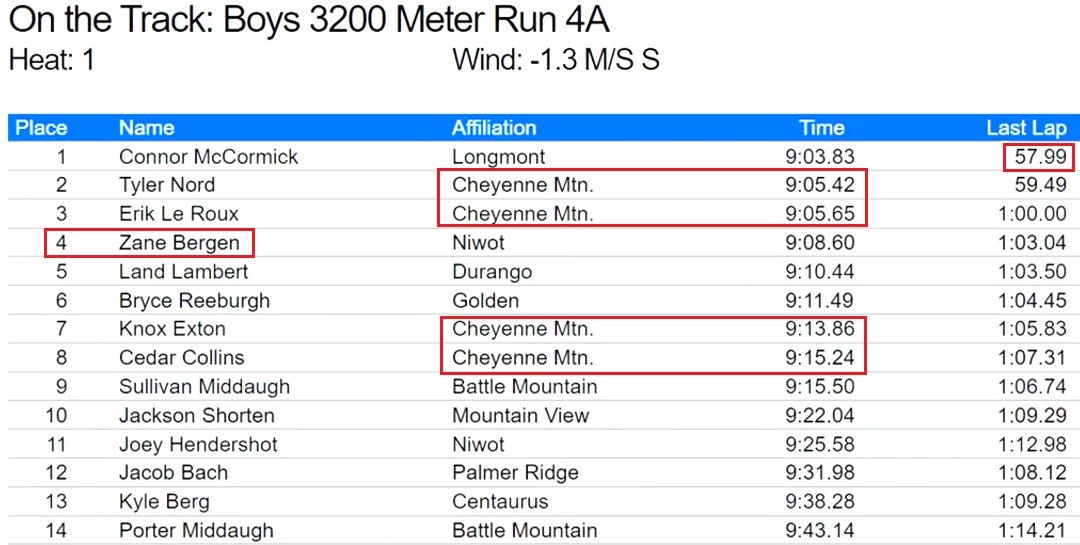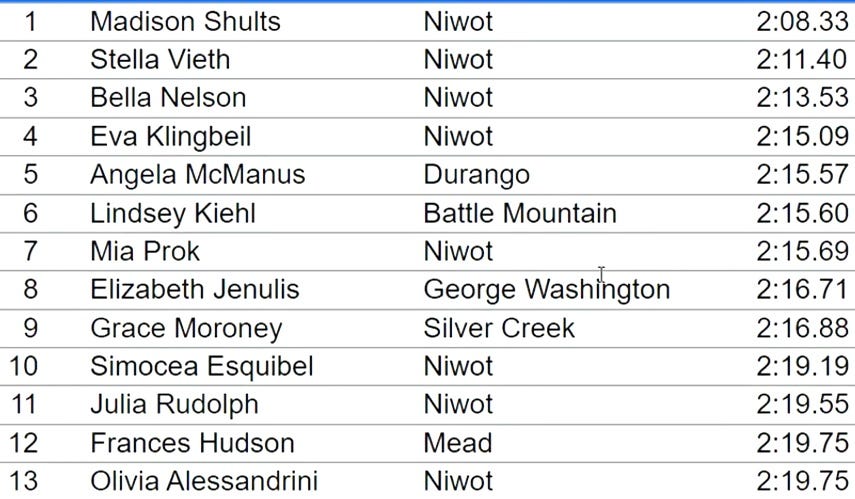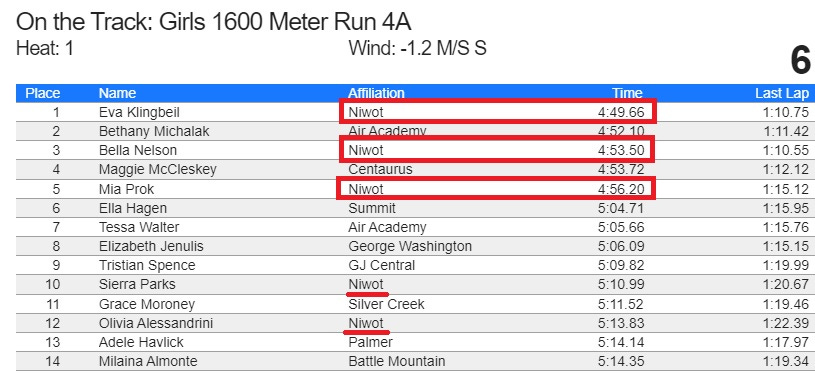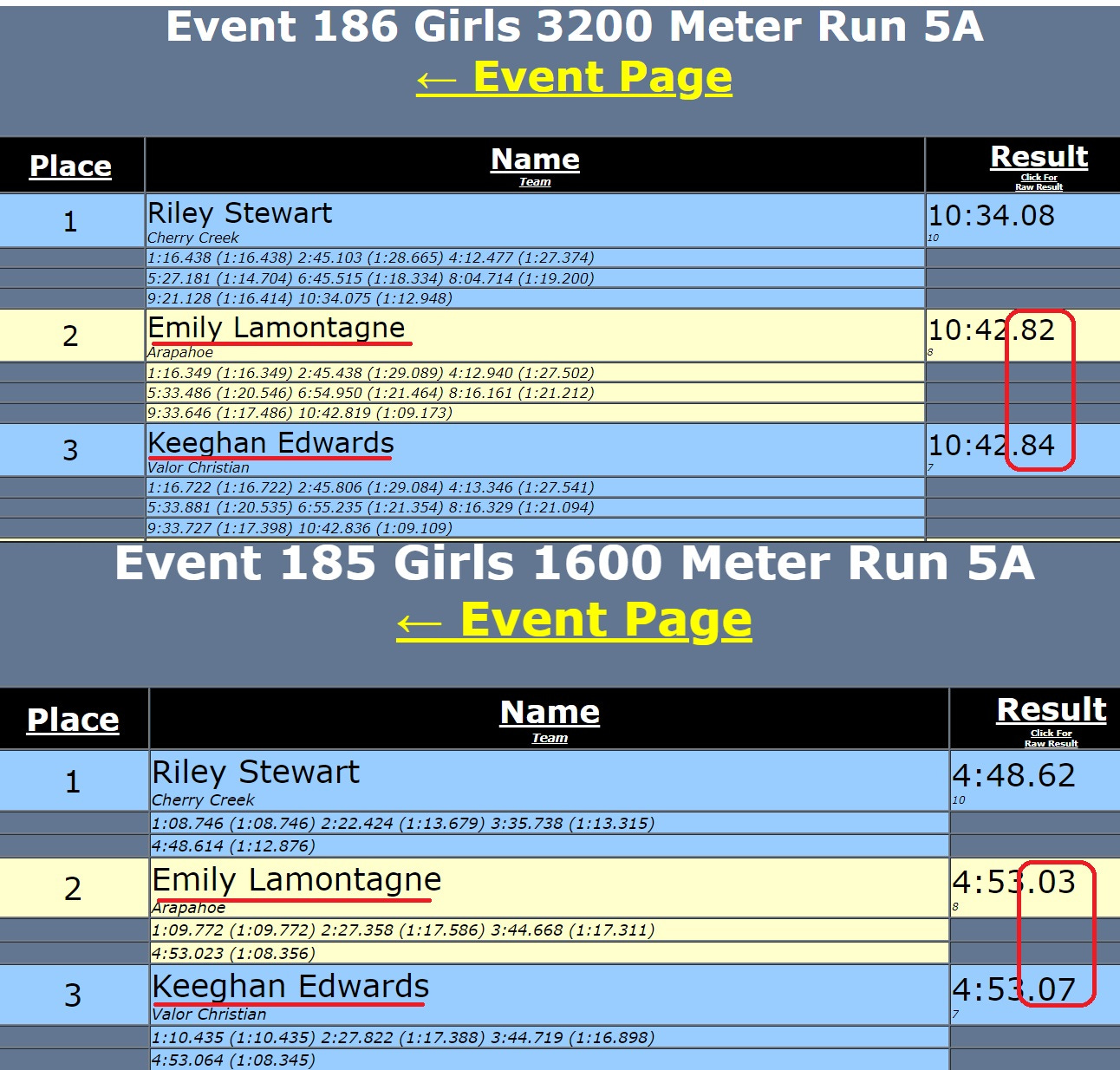The Colorado State Championships: 4A steals the distance show amid a weather-enforced intermission
It's fun to imagine an oxygen-infused version of this showcasing of talent
In my Wednesday announcement about the then-impending, now-completed Colorado State High-School Track and Field Championships (results), I wrote that the three-day layout had the 3,200-meter races for all five classes (1A through 5A) on day one (Thursday), the 800-meter races on day two (Friday) and the 1,600-meter races on day three (Saturday).
In fact, three of the five classes held their eight-lappers on Thursday, while the other two were supposed to go first thing Friday morning. I assume the schedule rotates from year to year to distribute the Friday-morning 3200-meter burden fairly across classes over time, but the obvious intent is to give kids tripling in the 3,200m, 800m and 1,600m as much rest as possible between events. It’s not a lot of fun, though, to run a 3,200-meter championship race in the morning and return 10 or so hours later for an all-out 800 meters, so my goof was nontrivial.
As things played out, day one went as scheduled, but a dramatic, mostly peaceful shift in conditions from the mid-eighties on Thursday to a snowstorm on Friday forced the postponement of the remaining events until Saturday, with no promise that Saturday would be any more materially permissive of a track meet at JeffCo Stadium than Friday had been.
(Boulder High and Fairview High were both scheduled to have their graduation rehearsals on Friday, with the final day of required schooling of their lives occurring on the eve of a significant snowstorm. #Colorado, in-frigging-deed.)
The CHSAA was in fact able to re-open the championships on Saturday. From what I can gather, the meet was simply delayed by a day save for a few scheduling adjustments that had little or no direct effect on the events of (my) interest—the two-, four-, and eight-lap individual races.
Before reviewing the results, a descent into wonkishness.
To determine the effect of a given altitude on a given event, I have always gone to this page, found the venue with the altitude closest to that of the venue of interest (if it’s not among the 36 stadiums listed), determined the percentile effect of altitude on the event of interest using the absolute values of the conversions given (picking an event of similar duration if the event of interest is not included), and adjusted the resulting percentage up or down in my head—that is, interpolated—to get a solid estimate of the conversion.
This time, I decided to plug some values into Excel, plot a couple of graphs, and produce a couple of equations relating altitude to “altitude penalty” in the 1,600-meter and 3,200-meter races, thereby removing most of the guesswork. I say “most” because I only used four (disparate in value) data points and a linear rather than exponential best-fit equation. As the tired saying goes, good enough for Substack work.
The y-axes in these graphs display percent penalty, while the x-axes show altitude values in thousands of feet.
This means that for runners competing at JeffCo Stadium (elev. 5.551K feet), their 1,600-meter times are slower, on average, by 2.79 percent, while their 3,200-meter times suffer by 3.17 percent.
I believe that the conversions used by the NCAA were determined empirically by aggregating thousands of race results at various locales and seeing how the same runners perform in the same events at sea level, or something like that. If so, the likely result is to underestimate how well kids born and residing at altitude perform at altitude, because most of the data points come from sea-level residents racing unacclimated at high altitude.
The upshot is that when I say four kids from the same school recorded altitude-converted sub-9:00 performances in the same race on Saturday—which they did—it doesn’t necessarily mean they would have done so in San Diego, all else being equal. Most of these kids were born in Colorado (a big altitude “get”) or have resided here for some time. But it’s as good a way as exists to examine high-altitude performances, and it gets you closer to the right digits than asking the person with the BAA jacket next to you in Starbucks will.
The 800 meters, being a two-minute-ish race, is considered minimally affected by altitude—even in Gunnison, Colorado, at over 7,500’, the conversion factor is only about a second and a half for sub-2:00 types. Most people who have raced that distance at both altitude and sea level grumble about this, probably because the 800 meters is easy to screw up and even a top athlete’s times tend to be all over the place no matter where they run (see: Clayton Murphy, Bryce Hoppel, et al.). I think a second at JeffCo stadium is fair, but by this point you should be tired of thinking about any of this.
Now then. In addition to ignoring the field events, the sprints, the hurdles, and (sadly) the relays, I am also for the most part omitting what happened in the 1A, 2A and 3A distance races, because the twelve boys; and girls’ 4A and 5A 800m, 1,600m and 3,200m races provided more than enough oomph for this eager but not-connected observer.
Thursday
5A girls’ 3,200m: Cherry Creek’s Riley Stewart having already run 10:06 at around 5,850’ this season (think 9:46 in, say, San Diego) made this event especially exciting by fiat, even if Stewart having two events and a relay after the 3,200m implied that she’d be holding something back. And she did. Stewart ran 10:34.08 for an easy win, while Arapahoe’s Emily Lamontagne edged out Keeghan Edwards of Valor Christian for second, 10:42.62 to 10:42.84.
Arapahoe High School’s girls’ cross-country team wound up #4 in the nation last fall per Milesplit’s ranking system, while Cherry Creek stood at #7 and Valor Christian at #21. None of these teams, however, brought even close to the best overall girls’ distance crew to the championships.
5A boys’ 3,200m: Oddly, there were only four seniors in the 18-runner field. Winner Drew Costelow of Valor Christian was not among them, as his 9:19.18 led a 1-2-5 VC effort. Ninth-graders from different schools ran 9:40 and 9:45, worth around 9:22 and 9:27 at sea level.
Saturday
4A girls’ 3,200m: The girls of Niwot High School, the institution boasting the #2 cross-country team in the U.S. last fall behind Saratoga Springs, New York, are good enough to make their teachers almost forget about old-timers like Elise Cranny and Cruz Culpepper. They got their rollicking weekend off to a neat start with this contest by grabbing places 1-5-6.
With the 3.17-percent altitude adjustment, the four times of the Niwot girls become 10:10, 10:48, 10:49, and 10:56. This wasn’t even close to the Niwot girls’ best effort on the day.
4A boys’ 3,200m: Like the Niwot girls, the boys of Cheyenne Mountain (Colorado Springs) rose to the #2 spot nationwide in Milesplit’s final cross-country ranking last autumn, and they also did it as 4A-classification school. They brought their strongest horses to this race, and the results were astonishing.
Not just the CM gang’s, either. This race was most visibly a face-off between Niwot’s Zane Bergen and Longmont’s Conor McCormick. Bergen swept the 800m, 1,600m and 3,200m races at these championships a year ago, while McCormick was second to Bergen in the two shorter events and eschewed the third. McCormick, in fact, came into the race with a personal best of 9:24.07 from April, a time he nearly matched three weeks ago. Bergen carried a PR of 8:44.71 into the event, having run that at sea level in April at the Arcadia Invitational in California to place third behind two Newbury Park athletes. That is worth about 9:02 at JeffCo stadium, considerably faster than Bergen’s high-altitude 3,200m best of 9:16.24 from 2021.
McCormick, though a comparative ingenue in the event, had beaten Bergen—who ran a 4:02.64 mile over the winter—at 1,600 meters at the Boulder County Championships back in mid-April, 4:11.13-4:12.30. And this would be just the first of their three duels at the 2022 CHSAA State Championships.
I’m too lazy to write these days, so I’ll let pictures again tell the story.
McCormick ran almost 21 seconds faster than ever before by splitting 4:38/4:25 and running a closing 800 meters of 2:03.6. Bergen ran his best-ever in-state 3,200 meters by a solid margin, but the runner who had placed third at the mega-prestigious Arcadia Invitational was beaten back to fourth in his divisional state championship.
Cheyenne Mountain’s foursome produced altitude-adjusted times of around 8:47, 8:47, 8:55, and 8:57. And that’s with the leaders going through 2,400m in 7:00, which is 9:20 pace and 9:02 altitude-adjusted pace. As nuts as that is, Newbury Park had four runners actually break 9:00 at Arcadia this spring and a fifth run 9:02-something on what was for him a dismal day.
McCormick had also run the anchor leg of Longmont’s 4 × 800m team on Thursday afternoon, helping his team place second to—get this—Cheyenne Mountain. Niwot did not enter a team, and hence any Bergens, in that relay. Perhaps the unplanned day of rest helped McCormick rally in the 3,200m more than he would have otherwise, but he looked plainly dominant in outkicking a 1:50.01 800-meter kid.
5A girls’ 800m: Stewart was gunning for her second title of the meet on Saturday afternoon, by which time the temperature was dropping into the high thirties, and on the starting line held a PR of 2:08.23 from last spring. But she probably expected resistance from her teammate Kinsey Christianson, who won the event at the 2022 New Balance Indoor National Championships in 2:10.47.
It turned out not to be especially close—in Christianson’s favor. The Iowa State-bound senior went to the front and gradually edged away from Stewart over the last 250 meters to win by 2.81 seconds in 2:07.25.
5A boys’ 800m: Costelow added a second individual title by taking this one in 1:52.11, edging Chatfield’s Camden Law by 0.14. The first nine runners came from nine different schools, a detail that will seem more relevant in about 20 seconds.
4A girls’ 800m: The 4A boys’ 3,200 meters was special. This race was almost unbelievable.
I have yet to mention that each 800-meter final included an unwieldy eighteen runners.
Treating these as sea-level times and ignoring the cruddy weather, Niwot could produce a 4 × 800m “A” squad capable of sub-8:50 and a “B” team capable of sub-9:15.
If you surveyed this spring’s results from across the country, you would find more than a handful of states with fewer than eight sub-2:20 girls. Niwot High School alone has at least eight.
4A boys’ 800m: Bergen and McCormick went at it once more. Bergen prevailed with relative ease this time, 1:52.07 to 1:54.45, and looked from the start like he meant business. That’s the way to handle a relatively shocking setback earlier in the same day, on the same track.
Sunday
4A girls’ 1,600m: What would Niwot do for an encore? Actually, a better question is “What’s 2.79 percent of five minutes?”, the answer to which is “8.4 seconds.”
4A boys’ 1,600m: By this time, all of Colorado was tired of watching Zane Bergen race Conor McCormick. But for the third time in two days, they vied for a state title. For the second time in three tries, McCormick got away from Bergen late after the Stanford-bound runner led aggressively from the gun before allowing the pace to lag, perhaps more confident in his kick after his “easy” 800-meter win the afternoon before. It didn’t work.
5A girls’ 1,600m: Stewart rebounded from losing the 800m by charging through a 68-point opening lap and finishing well in the lead in 4:48.62. Actually:
5A boys’ 1,600m: Costelow added his third crown of the meet by running 4:13.09, with two additional returning Valor Christian runners finishing in 4:16.80 for 4th and 4:17.34 for 6th.
Substack says this is almost too long to send, so I hope that’s plenty of color. I’m also my own proofreader tonight, and you know how that goes. And if you care about team scores, like some track followers seem to, those are here.
I have other work to do this week, but in the next few days will publish a story about the dispiriting—and I mean that—and predictable mass-beheading of Outside, Inc. personnel.





